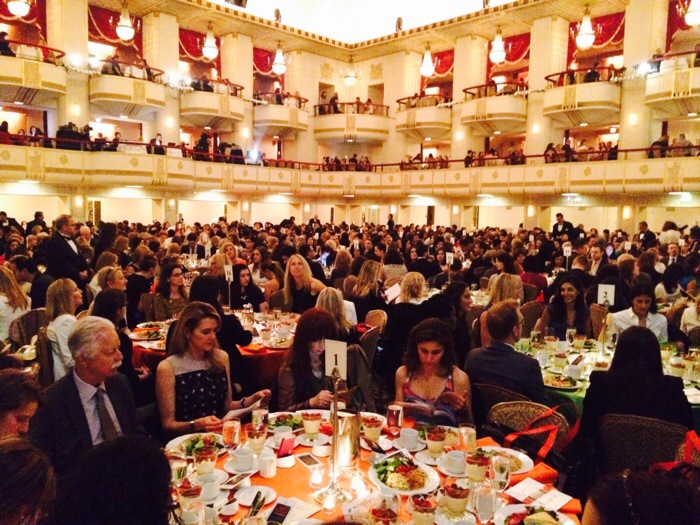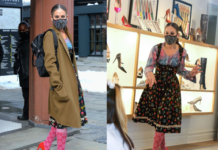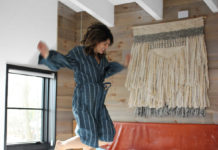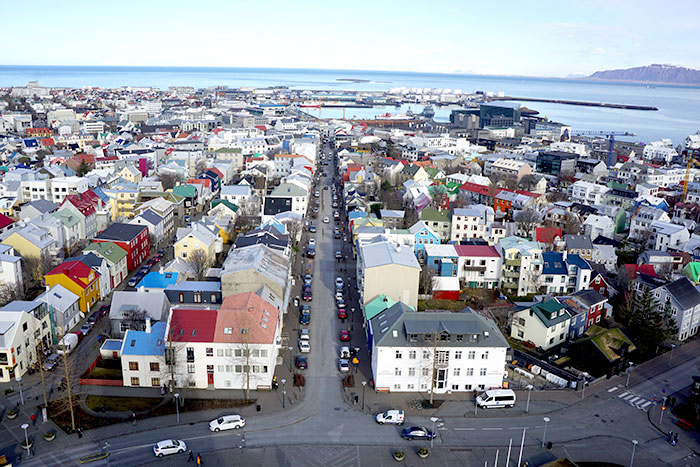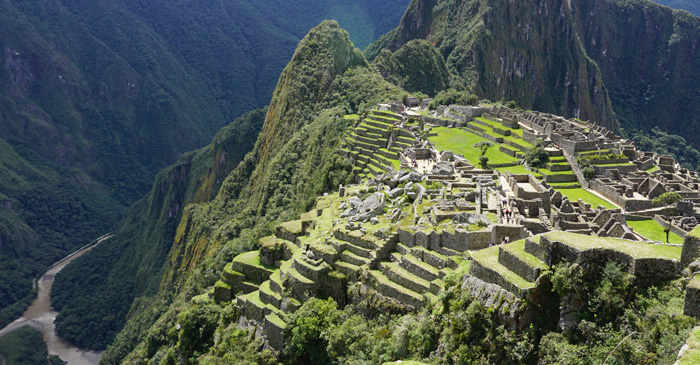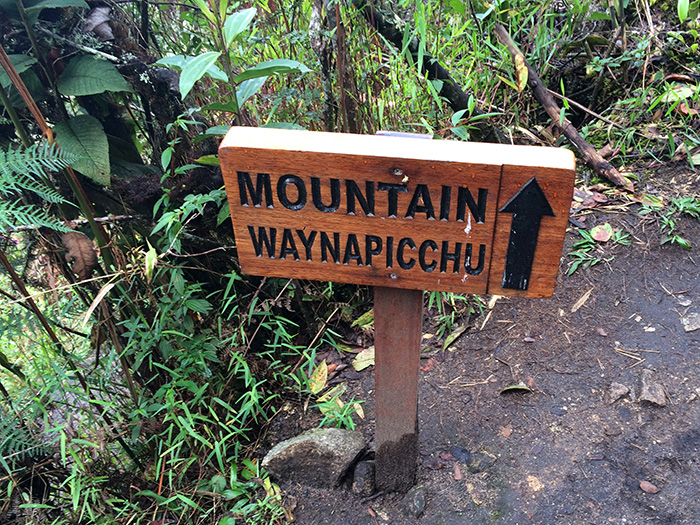One of the seven wonders of the world and a testament to the abilities of the Inca people, Machu Picchu sits high in the Andes, its location so remote that it remained undiscovered by the outside world until 1911. While we traveled all over Peru, this segment was the focus of our trip. Many choose to hike the Inca trail (Enigma Aventure Tours came highly recommended to us by friends), however we wanted to explore the Sacred Valley and see everything (or at least get a taste) so we carved out 10 days to explore the region with stops at every town and visits to a variety of hotels, restaurants and activities.

Getting there and altitude
If you plan on visiting this great wonder, your trip will most likely start in Cusco, the heart of the Inca Empire and then route towards Aguas Calientes, the town you enter to access Machu Picchu. Many take a 20+ hour bus ride from Lima to get to Cusco, but in the interest of time and sanity we flew a 1 hour 30 minute flight from Lima to Cusco.
Going to higher altitude (especially via plane) can make you very, very sick! Take this seriously and get a prescription for dioxin from your doctor in advance, drink tons of water and account for at least 1-2 days of being out of it before taking on any major activity. If you’re hiking pay special attention as you will get exhausted easier, we met a girl that had to be strapped to her horse she was so sick, a terrible way to spend your time on holiday.
Here’s a map from Cusco to Machu Picchu within the Sacred Valley so you can follow along with our tour.
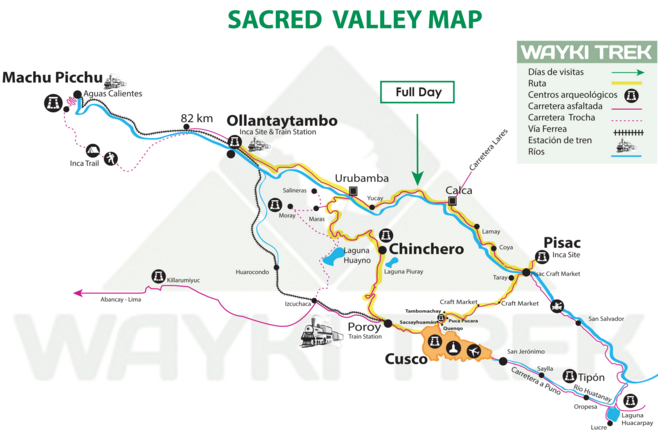
Our advice is also not to stay in Cusco when you arrive, save it for the end of your trip as it is higher elevation then the Sacred Valley and Machu Picchu. After arriving at the airport head straight for Urubamba, Ollantaytambo or Aguas Calientes as they are lower altitude. Urubamba has nice luxury options while Ollantaytambo has more to explore and a backpacker hostel feel.
By going to lower altitude, taking dioxin (there’s also a homeopathic version they sell at the local pharmacies in Peru) and keeping hydrated we had no problems. Since we wanted to spend time in Cusco, we planned two days on the way out, this way we would start at a lower elevation and slowly go higher.
After landing, we took a cab from Cuzco to Urubamba (60-80 soles) which included a scenic drive and a stop in Chincheros on the way. We ended up hiring our initial driver, Avi on several occasions, he an independent tour guide that speaks English and Japanese. Not to mention he’s a genuinely nice and incredibly knowledgeable guy. His rate is around $50 for a half day and $100 for a full day. Buy him lunch or kick him $10 for gas while you’re at it. He’ll make sure you see all of the major ruins and highlights in the Sacred Valley.
Avi’s contact: Phone: 51-084-632661/Cel: 984-4875591
Email: [email protected]
Cincheros
While you are going through the Sacred Valley from Cusco to Urubamba, check out Cincheros, a small area with great culture and markets with handcrafts. Goods tend to be a bit cheaper here (and in Pisac) then you will find elsewhere. Be sure to know what you are looking for and if you get into pricier fabrics such as Baby Alpaca, know how to spot genuine articles!

These fine ladies are skilled artisans who make and dye their fabrics, crafting them into clothes and other goods. I also learned about how they make the cochinilla bug into a striking and versatile red dye. While it has very old and traditional beginnings, it has had a lot of controversy lately as a food dye or additive – recently Starbucks was taken to task for a drink that included cochinilla because it is not vegetarian.
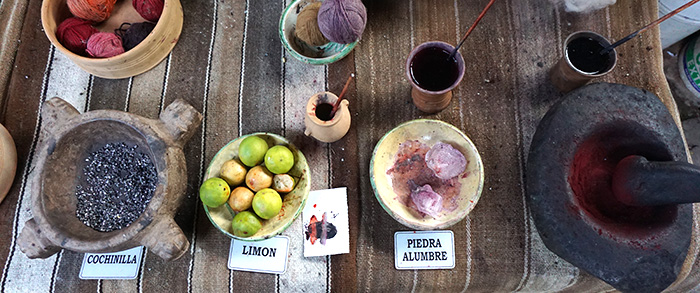
They even used it as lipstick, sometimes mixing it with different minerals to change the shade of it.

Urubamba
There’s really one main reason to visit Urubamba and that is to acclimate in style. It’s low altitude and proximity between Cusco and Machu Picchu makes this the ideal resting spot. That and it’s luxury hotels which offer comfort…and oxygen tanks should you feel a bit under the weather.
Urubamba is the home to ‘Giant Corn’ which we ate mostly in its dried snack version. Be sure to try it, it’s not as sweet or tender as North American corn but it’s an experience you can’t leave the region without trying. It has a small city center and a street full of restaurants but otherwise not much going on — which is why we chose to rest hear and enjoy our five star hotels to recover in comfort. We knew we’d be in no shape to explore our first few days (although we’re considerably in better shape then planned thanks to the altitude pills and getting out of Cusco as soon as we landed).
Where to eat
We went to Paca Paca for dinner – good food, charming atmosphere. Pizza Wasi for delicious brick oven pizza, or Kaia was good for vegetarian fare, very earthy atmosphere.
Where to Stay
The Inkaterra Hacienda Urubamba – Built as an Andean ranch, with incredible décor and artifacts. Free guided tours, bird watches and night hikes and a no-charge minibar. Fresh and rejuvenating, a great place to get back to nature and acclimate to the altitude. Read the full review here.

The Tambo Del Inka Hotel – A Luxury Collection hotel, this amazing property also is part of the Starwoods group and if you have a lot of hotel points its worth spending them here. Huge vaulted ceilings, cozy fireplaces and beautiful grounds with the Urubamba river in the backyard. Request ground level river facing room and you have a quick walk to the river. Read the full review here.
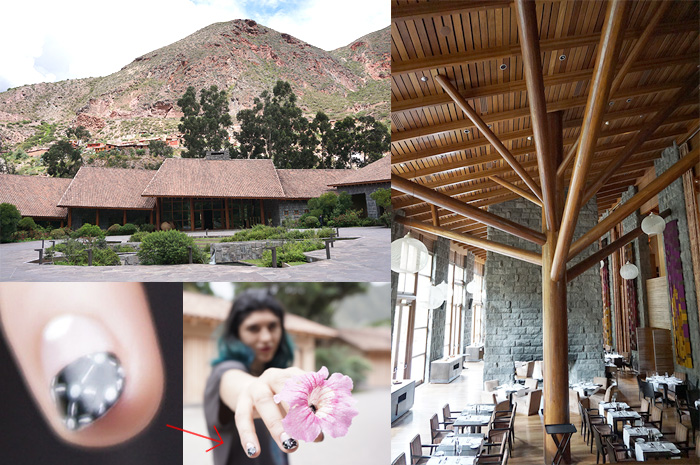
Ollantaytambo

Say it with me: oh-yan-tay tambo
A beautiful town filled with markets and ruins, it is the last stop before Aguas Calientes and also the cheapest place to take the train from. There is great hiking on both sides of the city with views from on high at the agricultural ‘drying house’ and humbling stonework all through the emperor’s ruins.
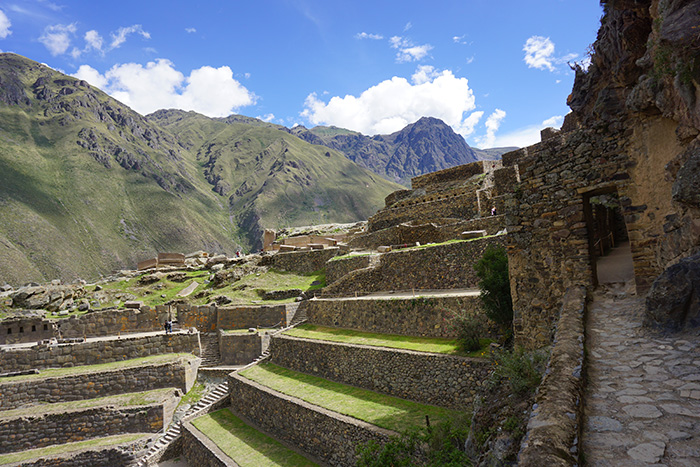
We spent the day in Ollantaytambo before taking our train to Aguas Calientes, which is the town next to Machu Picchu. There was a lot more to see here than in Urubamba, give yourself at least 4 hours. It was an emperor’s estate and the stonework in the ruins as well as around town are incredible.
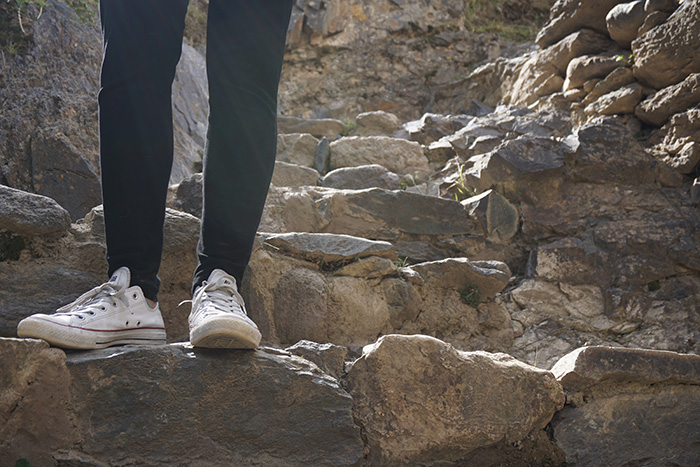
Left: All doorways are made with huge stones fit together with utmost precision. Right: Shops sell traditional hand loomed alpaca products, many of them support local communities and artisans.
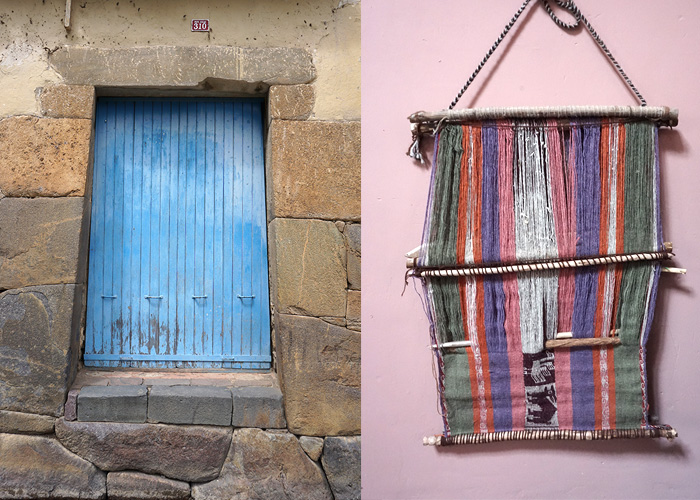
Where to eat: Hearts Café – great vegetarian options, burgers and free wifi. Communal and charity focused.
Aguas Calientes
A small town right next to Machu Picchu, the only way in is by train. Things are a bit more expensive here, if you can buy supplies earlier that’s ideal.
We took both Peru Rail and Inca Rail, which are moderately expensive for the length of the ride, but I could only imagine how much it cost to put the railroad track in and maintain it. From Ollantaytambo, both trains are the same level of comfort and offer snacks and coffee/tea and within the same price range so just go with whichever is cheapest. If it’s the same price, go with Inca Rail since it is the Peruvian owned line, with profits staying in the country and local community.
Aquas Calientes is about a mile wide and most people only stay here when going to Machu Picchu, there isn’t much to see in the town itself. Main attractions are the Main Square, Church, Central Market and hot springs. None of which are must dos. Restaurants and other tourist services are plentiful.
Normally, we’re fine in a hostel/bed and breakfast type of accommodation, however considering how wet Aquas Calientes was (even when it wasn’t raining) we strongly recommend booking a nicer hotel in this area. The Inkaterra properties are all top notch, we stayed at the El Mapi and loved it. A well designed, modern boutique hotel with good food located in the center of town.
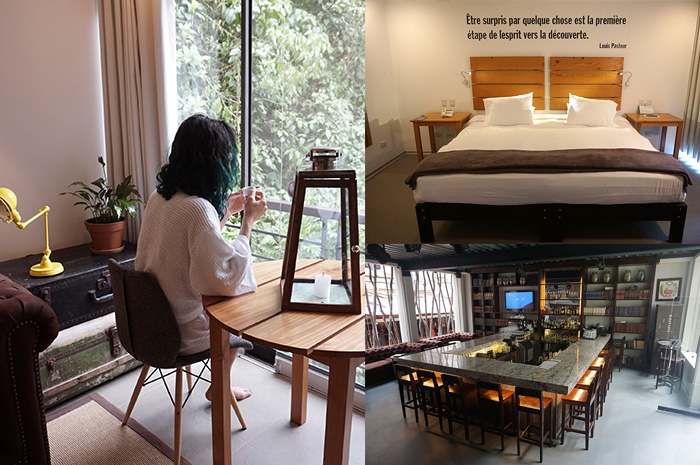
It sister hotel, the Inkaterra Machu Picchu Pueblo Hotel is situated by the train station and boasts beautiful grounds and offers activities such as hikes and tours of their gardens, which is where they get most of the ingredients for their food! Their hot tub is actually much better than the public ones in town, for which the town is named for. The property is beautiful and the accommodations are a bit more private — if there are any honeymooners reading this, book here! Or at least stop by for lunch.
If you are wanting a day hike or just want to burn off some energy, there are some options from the Inkaterra Machu Picchu Pueblo Hotel. You can also follow the river for a while and find some off the trail options, especially if you go towards Hidroelectrica, which is the way that many hike in to Aguas Calientes. There was a trail to a mountain that looked incredibly tempting, however the trail seemed to be undergoing restoration so we stayed off.
Machu Picchu
Finally! No matter how you get here, it takes a while and some good effort, unless you flew in by helicopter. For this day trip you will want to bring ample water, sunscreen, a hat and possibly a pancho. Most of these items can also be found on premises. It can get temperamental here, changing between cloud forest and intense sun so be prepared but not weighed down. Definitely look at the weather report prior to going.
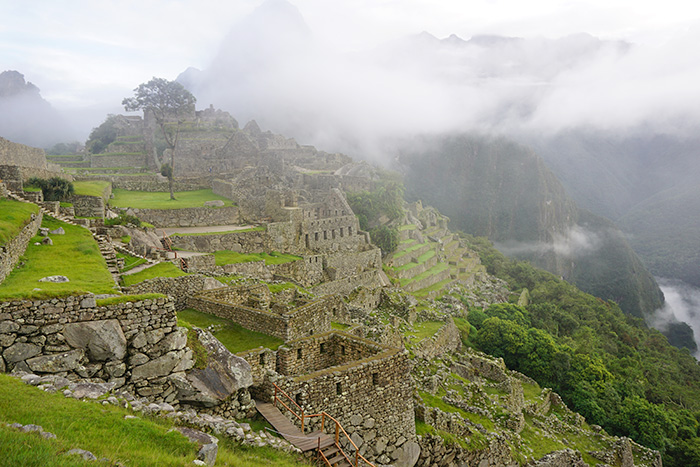
There is a rich history and I’ll spare you the details other than it is breathtaking and one of those moments that you think, “How did they DO that?!”. Truly incredible. We managed to score the tickets that included the Huayna (Wayna) Picchu hike, a 2 hour or so hike up the mountain next to Machu Picchu, which promises great views of Machu Picchu itself. It is a moderate hike so take into consideration your stamina, health, limits and any fear of heights you may have.
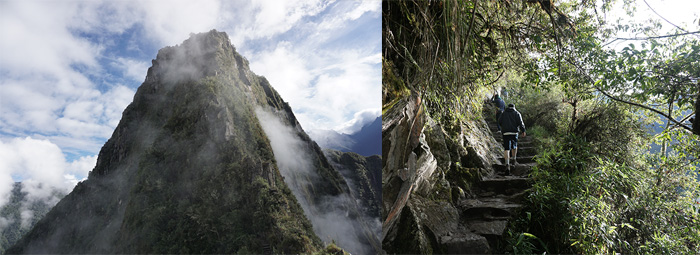
Only 400 people can go per day and we barely got ours. A tip is to go for the 10a-12a viewing as sometimes it takes a while for the clouds/fog to burn off in order to get a good view. As you can see, the view of Machu Picchu from the top of Huayna is pretty inspiring!
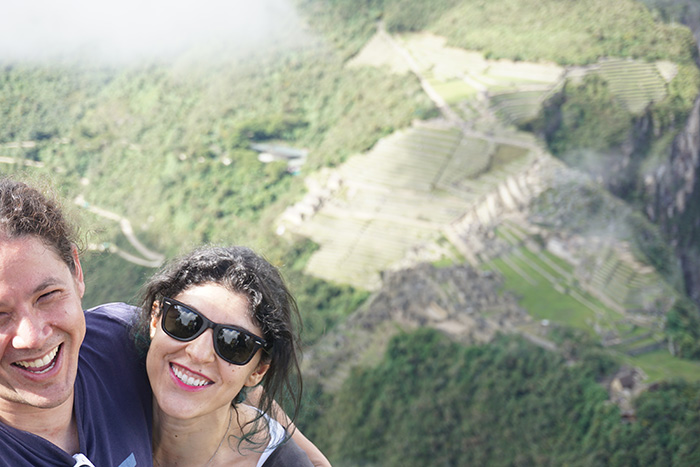
If you want to attempt this or the other mountain (called Montana), definitely get your tickets in advance at http://www.machupicchu.gob.pe/. If you aren’t able to, you may miss some views of Machu Picchu from up on high, but there is plenty to see regardless – more than you can cover in one day.
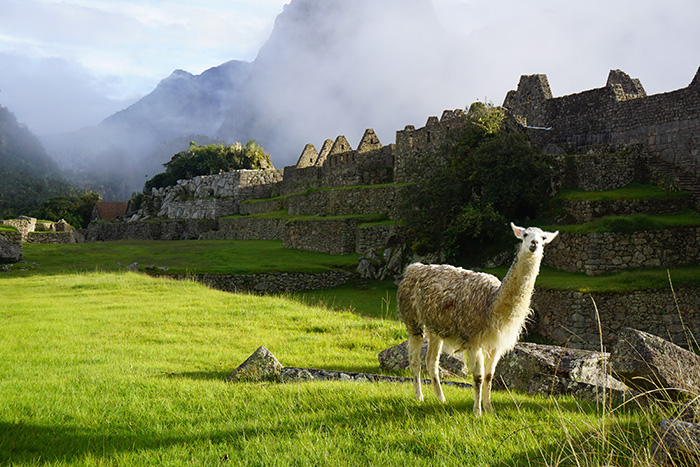
You aren’t supposed to bring food, but everyone seems to. Just don’t leave any trash behind and pick some up if you see it. We didn’t pack any in because we were feeling too lazy the night before and found that the lunch options are inexpensive and bland with gigantic portions or the overpriced $40USD Belmond buffet.
Don’t forget to use the bathrooms at the entrance. There’s re-admission back into Machu Picchu, however there’s not bathrooms on the grounds and it’s annoying to go in and out.
After a good day’s hike, we fully recommend a massage and hot tub before heading back towards Cusco, one of the most beautiful cities in Peru.
If you have any questions, tweet me @prettyconnected. xoLara



